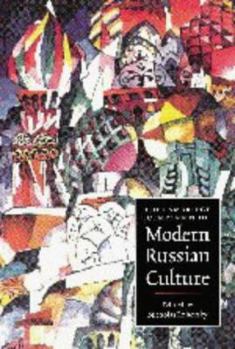The Cambridge Companion to Modern Russian Culture
(Part of the Cambridge Companions to Culture Series)
Select Format
Select Condition 
Book Overview
Russia's size, the diversity of its peoples and its unique geographical position straddling East and West have created a culture that is both inward and outward looking. Its history reflects the... This description may be from another edition of this product.
Format:Paperback
Language:English
ISBN:0521477999
ISBN13:9780521477994
Release Date:February 1998
Publisher:Cambridge University Press
Length:404 Pages
Weight:1.45 lbs.
Dimensions:0.9" x 6.0" x 8.9"
Customer Reviews
1 rating
ROOTS AND FLOWERS
Published by Thriftbooks.com User , 24 years ago
This book is comprised of 12 brief, well-written essays by distinguished researchers, put together by the SUNY Stony Brook professor Nicolas Rzhevsky. The volume is divided into two parts: Cultural Identity and Literature and the Arts. If the first part of the book deals with Russian roots, the second is devoted to the flowers of this civilization.On the crossroads of these narratives we see a vast land, stretching from East to West emerging from the union of Slavs and Vikings somewhere around the middle of the eighth century as a number of relatively small cities and tribes. Locked in the never-ending war with nomads prince Vladimir tries to unite them around Kiev. In his first attempt he tried to use paganism. He builds up a gallery of local pagan gods, trying to achieve some kind of union and establish certain hierarchy on the symbolic level. Seeing the futility of these attempts, however, he drops pagan faith altogether and adopts Byzantine (`Orthodox') Christianity, which is not dependent on local gods.As we learn from the essay on Religion by the leading Russian Academician Dmitry Lihachev, having a choice among Islam and other versions of Christianity Vladimir chooses Christianity for the beauty of Byzantine rites and rituals. It is by the beauty of religious acts that God was introduced to the Russian land and the remaining ancient churches testify that because of the beauty God stayed. Church became the place where artists could realize themselves as architects and painters. Christianity also brings a new alphabet. It to this epoch that the first known texts date back.The ensuing unity enables Kiev to achieve a number of important victories in the wars with nomads. However, Kievan Russia was not strong enough to withstand the Mongol invasion from 1237 to 1240, when Kiev was burned. It became a part of the Golden Horde on a par with Greeks, Poles, Georgians, Armenians, Mordvinians and other peoples. In fact, churches were among the few institutions that withstood the invasion and secured the identity of the Russian land, because pagan Mongols respected all kinds of gods `just in case'. It is by the boundaries with the West and the East (which included all the Southern people, pagans and Christians alike). While West equated civilization, East was considered a territory for conquest and expansion. It is tempting to see eastward Russian expansion as a mirror of the westward colonization of the North American continent. Indeed in California and Alaska American and Russian settlers meet. It is also important to note that some of the colonizers were fuelled by religious passions over the conflict of starovery (old-believers) with the official reform of the Church by Peter the Emperor. Starovery did not accept the reform of religious rites and were prosecuted heavily by the state and church alike. They found their freedom on the frontier of Russian colonization. By the conquest of `East' Russia eventually established itself as a Western power,





